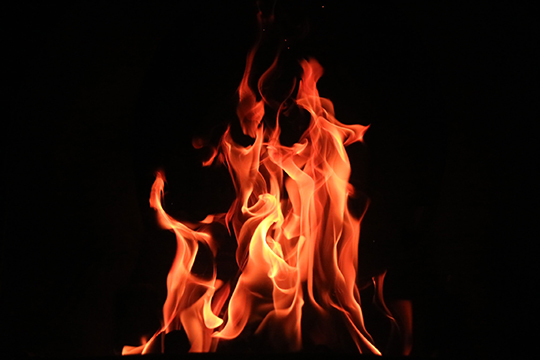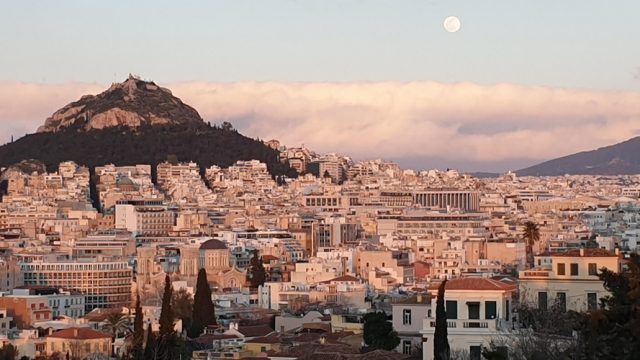“When the Day of Pentecost came, they were all together in one place. Suddenly a sound like the blowing of a violent wind […]

“When the Day of Pentecost came, they were all together in one place. Suddenly a sound like the blowing of a violent wind came from heaven and filled the whole house where they were sitting. They saw what seemed to be tongues of fire that separated and came to rest on each of them. All of them were filled with the Holy Spirit and began to speak in other tongues as the Spirit enabled them” (Acts 2:1–4).1
Certain images grip us so compellingly that they define a moment, event, or an era.
Gripping Photographs
Such images include a photograph taken in 1966 of a solider sinking his nose into a letter to savor the scent of the sender from back home. Other iconic images include the flames blazing from the Notre Dame Cathedral in Paris as Parisians stood in utter shock at the dramatic sight before them; and that freeze-frame moment of Odell Beckham, Jr.’s spectacular one-handed catch when he scored a touchdown against the Dallas Cowboys in 2014.
One photo I saw recently movingly conveys the reality of the restrictions of the COVID-19 pandemic.2 It’s a picture of an elderly woman kneeling at the entrance of the Westminster Cathedral in Central London. With her hands grasping at the two misleadingly inviting doors, she sorrowfully comes to the conclusion that the doors have been padlocked on Good Friday—the day the veil of the temple was torn in two during Christ’s crucifixion (Matt. 27:51).
If only someone could have walked up to that faithful daughter of God and told her that although the doors of the church were closed, God has placed a heavenly door before her that no one can shut (Rev. 3:8).
During this pandemic, there has been real confusion about the Christian church—specifically about its nature. What are the essential characteristics of the church? Can a church be closed? Is the church a building?
We will seek to answer these questions in the light of Scripture as we look at the verses that detail the birth of the church in Acts 2.
A Violent Wind
Before His accession to heaven, Jesus had instructed His disciples to wait in Jerusalem for the promise of the Holy Spirit. As they gathered in the upper room to prepare themselves for receiving the holy Spirit, the Bible says a violent wind filled the whole place. If you know anything about wind, you know how forceful it can be.
A powerful storm recently came through the town where I live. It was accompanied by gusts of wind so powerful that they uprooted our 60-foot oak tree and toppled it to the ground.
Wind has the power to move things around. We enjoy cool breezes on a summer day, but reluctantly appreciate the winds that move things around in our lives. We often pray, “God, I want you to work in my life, as long as you don’t change specific things.” We can often be drawn to sermons that require others to change, but we quickly get uncomfortable when we hear God say, “To change your situation, I first need to change you!” Those who gathered together in the upper room were totally surrendered, waiting for God to change their priorities and their lives as they sought His will. This session of surrender was the church’s beginning point.
“The disciples prayed with intense earnestness,” wrote Ellen White, “for a fitness to meet men and in their daily intercourse to speak words that would lead sinners to Christ. Putting away all differences, all desire for the supremacy, they came close together in Christian fellowship. They drew nearer and nearer to God.”3
The birth of the church was not controlled by human effort; rather, the Holy Spirit took the initiative and filled the upper room. Can you think of areas in your life that you are trying to control right now? Could it be your kids, your spouse, a coworker, your online image?
“Anything controlled by us, whether lifeless or lively, is not Christianity” writes Martyn Lloyd Jones. “Christianity is that which controls us, which masters us, which happens to us.”4
A Wild Flame
The Holy Spirit is represented not only as wind but also as fire. Fire has been frequently used in the Bible to represent deity. God showed Himself to Moses as unsourced fire in a bush in the Midian wilderness (Ex. 3:1-4); and it was through a pillar of fire by night that God illuminated the path of His people as they ventured toward the Promised Land (Ex. 13:21).
The early church’s second step was the Holy Spirit illuminating the minds of Christ’s followers to the truths of God’s Word. The Spirit’s fire also equipped them to preach the gospel and to provide the zeal necessary to travel to the dark ends of the earth with power—a third consideration.
I remember being afraid of the dark as a kid. I would find comfort through “tried-and-true” methods, such as covering my head with a blanket or clutching my tiny keyring flashlight. This flashlight was novel because it would turn on every time I squeezed it. Although small, it filled my whole room with light. The presence of light made all my fears disappear. If only I could find that flashlight during life’s dark times.
Living through a pandemic can at times feel like living in the dark. We try our very best to navigate a once-familiar environment that has suddenly forced us to slow down and maneuver through unpredictable obstacles. But even in the midst of this pandemic that has cast its darkness upon all of our lives, there is a persistent glow of light that gives us hope. The apostle John wrote: “The light shines in the darkness, and the darkness has not overcome it” (John 1:5).
As we face this novel virus—a virus not seen before—could this also be a time that God will shine His light in ways we’ve never seen before? I believe that God wants to bring light into these dark times in ways we may not expect or even anticipate.
As news of the pandemic broke out on our campus at Southern Adventist University, I saw this light shine as students huddled together in an impromptu circle of prayer. I saw this light shine every time faculty and staff prayed with students who were wondering what the remainder of their school year would look like.
In the book Christ’s Object Lessons, Ellen White paints a picture of God’s redeemed just before He returns: “The last rays of merciful light, the last message of mercy to be given to the world, is a revelation of His character of love.”5 Early Christians overcame the darkness of this world through the flame of the Holy Spirit that shined in their hearts and empowered them to live out the revelation of God’s love to the world.
A Roaring Fire
So far, I’ve mentioned the wind and fire separately, but what would happen if we put these two symbols together? On its own, the wind of the Holy Spirit can bring down “oak-tree-sized” pride that reigns in our heart. On its own, the fire of the Holy Spirit can melt a seemingly impenetrable heart of sin. But when we place fire and wind together, the church of God will be an unstoppable roaring flame that overtakes the world with the hope found in Jesus Christ.
When wind is set to fire, it becomes impossible to quench. In 2019, officials in my home country of Australia urged more than 250,000 residents to flee from massive bushfires roaring toward populated regions as strong winds fanned unrelenting flames. In a period of about three months, fires scorched nearly 40,000 acres, an area the size of South Korea.6 Together, fire and wind are a mighty combination.
Imagine what would happen when the wind and fire of the Spirit are set in the hearts of God’s people. Would it not cause families, communities, and nations to see the power of God at work today? Who can deny the existence of God’s wind and fire when His people are set ablaze by His Spirit? Ellen White wrote: “Harmony and union existing among men of varied dispositions is the strongest witness that can be borne that God has sent His Son into the world to save sinners.”7
The Secret of the Change
It was not buildings that changed nations in the first century, it was people filled with the Holy Spirit. The world was not turned upside-down because of what the disciples did; it was turned “right-side-up” because of what God did in His followers.
I wish I could meet the woman who knelt in prayer at the door of Westminster Cathedral in Central London. I would ask her what led her to kneel before the church entrance and cling to the door handles that day. I suppose she felt that God would meet her during her moment of need.
There are many today, just like that dear woman, who are seeking to find God, but find the church doors closed. In Acts 2 we discover that the church God birthed was never intended to be closed. Instead, the wind and flame of Pentecost drives God’s people unstoppably forward, breaking padlocks, blowing down and burning up all the doors that stand in the way of gospel advance.
1 All Bible texts are from the Holy Bible, New International Version. Copyright ã 1973, 1978, 1984, 2011 by Biblica, Inc. Used by permission. All rights reserved worldwide.
2 www.nytimes.com, 4/11/2020, opinion/sunday/coronavirus-religion.html.
3 Ellen G. White, The Acts of the Apostles (Mountain View, Calif.: Pacific Press Pub. Assn., 1911), p. 37.
4 Martyn Lloyd-Jones, “The God Who Acts,” in Authentic Christianity, 1st U.S. ed., vol. 1, Studies in the Book of Acts (Wheaton, Ill.: Crossway Books, 2000), p. 22.
5 Ellen G. White, Christ’s Object Lessons (Washington, D.C.: Review and Herald Pub. Assn., 1900), p. 415.
6 www.cnbc.com/2020/01/10/australia-urges-a-quarter-of-a-million-to-flee-as-winds-fan-massive-bushfires.html.
7 Ellen G. White, Mind, Character, and Personality (Nashville: Southern Pub. Assn., 1977), vol. 2, p. 619.








